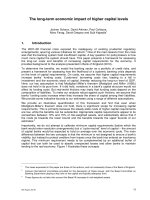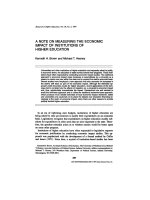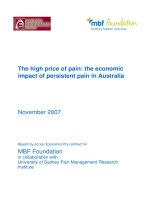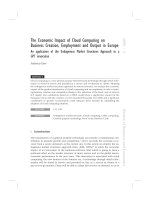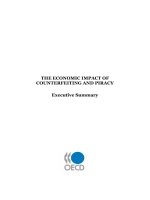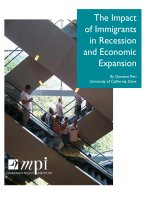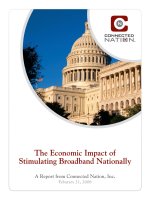The Economic Impact of the Iraq War and Higher Military Spending pptx
Bạn đang xem bản rút gọn của tài liệu. Xem và tải ngay bản đầy đủ của tài liệu tại đây (260.35 KB, 10 trang )
The Economic Impact of the Iraq War
and Higher Military Spending
Dean Baker
May 2007
Center for Economic and Policy Research
1611 Connecticut Avenue, NW, Suite 400
Washington, D.C. 20009
202-293-5380
www.cepr.net
ii
Contents
Executive Summary 3
Introduction 5
The Impact of Higher Military Spending: What the Model Shows 5
How Spending on the Military and the Environment Cost Jobs 8
Conclusion 9
Appendix 10
About the Authors
Dean Baker is Co-director at the Center for Economic and Policy Research in Washington,
DC.
The Economic Impact of the Iraq War and Higher Military Spending 3
Executive Summary
There has been relatively little attention paid to the Iraq War's impact on the U.S. economy. It is
often believed that wars and military spending increases are good for the economy. This is not
generally true in most standard economic models. In fact, most models show that military spending
diverts resources from productive uses, such as consumption and investment, and ultimately slows
economic growth and reduces employment.
In order to get an approximation of the economic impact of the recent increase in military spending
associated with the wars in Iraq and Afghanistan, the Center for Economic and Policy Research
commissioned Global Insight to run a simulation with its macroeconomic model. It produced a
simulation of the impact of an increase in annual U.S. military spending equal to 1 percent of GDP,
approximately the actual increase in spending compared with the pre-war budget (see appendix). We
selected the Global Insight model for this analysis because it is a commonly used and widely
respected model. Global Insight produced a set of projections that compared a scenario with an
increase in annual military spending equal to 1.0 percent of GDP (current about $135 billion)
relative to its baseline scenario. This is approximately equal to the increase in defense spending that
has taken place compared with the pre-September 11th baseline.
The projections show that:
• After an initial demand stimulus, the effect of higher defense spending turns negative around
the sixth year. After 10 years of higher defense spending, payroll employment would be
464,000 less than in the baseline scenario. After 20 years the job loss in the scenario with
higher military spending rises to 668,100 compared to the baseline scenario.
• Inflation and interest rates would be considerably higher in the scenario with higher military
spending. In the first five years, the annual inflation rate would be on average 0.3 percentage
points higher in the scenario with higher military spending. Over the full twenty year period,
inflation averages approximately 0.5 percentage points more in the high defense spending
scenario. After five years, the interest rate on 10-Year Treasury notes is projected to be 0.7
percentage points higher than in the baseline scenario. After ten years, this gap is projected
to rise to 0.9 percentage points, and after twenty years to 1.1 percentage points.
• Higher interest rates are projected to lead to reduced demand in the interest sensitive sectors
of the economy. After five years, annual car and truck sales are projected to go down by
192,200 in the high military spending scenario. After ten years, the drop is projected to be
323,300 and after twenty years annual sales are projected to be down 731,400.
• Annual housing starts are projected to be 17,900 lower in the high military spending scenario
after five years, 46,200 lower after ten years, and 38,500 lower after twenty years. The
cumulative projected drop in housing starts over the twenty year period is 530,000. The drop
in annual existing home sales is projected to be 128,400 after five years, 247,900 after ten
years and 286,500 after twenty years.
• Higher interest rates are projected to raise the value of the dollar relative to foreign
currencies. This makes imports cheaper, causing people in the United States to buy more
The Economic Impact of the Iraq War and Higher Military Spending 4
imports and makes U.S. exports more expensive for people living in other countries, leading
to a drop in exports. The model projects that in the high military spending scenario, high
imports and weak exports causes the current account deficit to increase (become more
negative) by $90.2 billion (2000 dollars) after five years, compared to the baseline scenario.
The current account deficit is projected to be $72.5 billion higher after ten years and $112.8
billion higher (both in 2000 dollars) after twenty years. The cumulative effect of higher
imports and weaker exports over twenty years is projected to add approximately $1.8 trillion
(in 2000 dollars) to the country’s foreign debt.
• Construction and manufacturing are the sectors that are projected to experience the largest
shares of the job loss. While construction is projected to have a net gain of 8,500 jobs after
five years, it is projected to lose 144,200 jobs after ten years and 211,400 jobs after twenty
years in the high military spending scenario. Manufacturing is projected to lose 44,200 after
five years, 95,200 jobs after ten years, and 91,500 jobs after twenty years in the high military
spending scenario. Two-thirds of the projected job loss is in the durable goods sector.
The paper notes that military spending is not generally perceived to cost jobs, however, in standard
economic models, its impact can be thought of in the same way as spending on the environment,
which is generally believed to cost jobs. While tax and emission restrictions are often used to achieve
environmental ends, it is also possible to reach environmental targets by paying people to do things
that will reduce pollution. For example, it is possible to reduce greenhouse gas emissions by paying
people to buy more fuel efficient cars and appliances, or paying them to install insulation and other
energy saving devices.
In the case of both increased military spending and paying people to take steps to reduce greenhouse
gas emissions, resources would be pulled away from their market directed uses. In standard
economic models, this redirection of resources will cause the economy to operate less efficiently and
therefore lead to slower growth and fewer jobs. In the scenario modeled in this exercise, higher
interest rates are the mechanism that slows the economy and leads to fewer jobs.
In policy debates, it is important to recognize the potential job loss from military spending. The
potential economic costs are often a factor in debates over environmental policy. Economic costs
should also be recognized in debates over military policy. It would be useful to have the
Congressional Budget Office produce its own projections of the economic impact of a sustained
increase in defense spending.
The Economic Impact of the Iraq War and Higher Military Spending 5
Introduction
The Iraq War has occupied a central place in U.S. politics over the last few years, however, there has
been relatively little attention paid to its impact on the economy. While the economic impact of the
war should be a relatively small consideration compared to its impact on the people of Iraq and the
soldiers who serve there, it is still important to recognize the cost that a prolonged period of higher
military defense spending will impose on the economy.
It is often believed that wars and increases in military spending are good for the economy. As a
general rule this is not true according to standard economic models. In fact, most models show that
military spending diverts resources from productive uses, such as consumption and investment, and
ultimately slows economic growth and reduces employment. In this way, military spending is
comparable in most models to any other form of government spending, such as spending on public
goods or improving the environment.
This paper shows the projections of the impact of an increase in annual military spending equal to 1
percent of GDP (approximately the actual increase in spending compared with the pre-war budget)
of the Global Insight macroeconomic model (see Appendix). The Global Insight model was
selected for this analysis because it is a commonly used and widely respected model.
1
Other models
will show somewhat different projections, but it is unlikely that the direction of the long-term
impact on any of the key variables will be different. In fact, because of the structure of the Global
Insights model, it likely understates the negative impact of military spending relative to other
models.
The next section of this paper describes the key projections of the Global Insight model. The third
section explains the economic logic by which higher defense spending could lead to lower GDP and
employment. This discussion is followed by a brief concluding section.
The Impact of Higher Military Spending: What the
Model Shows
Global Insight modeled the impact of an increase in annual military spending equal to 1.0 percent
of GDP beginning in 2007 and continuing over its 20-year forecast period. The forecast assumes
that there is no offsetting increase in taxes in order to isolate the impact of the increase in defense
spending on the economy. All other assumptions are exactly the same as in Global Insight baseline
model.
Table 1 shows the key differences in projections, at five year intervals, between the baseline model
and the simulation assuming higher levels of defense spending.
1
Global Insight was formed from the merger of WEFA and DRI-McGraw Hill, two of the oldest econometric
forecasting firms in the country.
The Economic Impact of the Iraq War and Higher Military Spending 6
TABLE 1
Differences Between High Military Spending Simulation and Baseline Forecast (Annual Rates)
5 years 10 years 15 years 20 years
Real GDP (billions 2000$) 80.8 -13.3 -11.3 -42.1
GDP Deflator (percentage points) 0.6% 0.6% 0.7% 0.7%
10-Year Treasury Note Yield (percentage points) 0.68 0.94 1.06 1.10
Nonresidential Fixed Investment -1.0% -1.0% -1.1% -1.0%
Industrial Production 0.4% -0.5% -1.0% -1.8%
Light Vehicle Sales (thousands) -192.2 -323.3 -472.0 -731.4
Residential Fixed Investment -1.3% -3.6% -3.5% -3.5%
Housing Starts (thousands) -17.9 -46.2 -38.4 -38.5
Exist. House Sales (thousands) -128.4 -247.9 -271.1 -286.5
Exports -1.9% -1.5% -1.8% -1.8%
Imports 2.0% 1.5% 2.2% 2.7%
Current Account Balance (Billions 2000$) -90.2 -72.5 -83.8 -112.8
Payroll Employment (thousands) 177.3 -464.0 -515.3 -668.1
Source: Global Insight and author’s calculations.
The first row shows the impact on GDP. Interestingly, the initial impact of higher military spending
on GDP is positive. In the short-run, the model predicts that increased military spending provides a
boost to the economy. The spending increases demand, which leads to more employment and
output. Payroll employment is projected to be 177,300 higher after five years than in the baseline
case. (The increase in military spending began in late 2001, so 2007 can be seen as comparable to the
6
th
year in these projections.)
However, the negative impact on most other variables can already be seen by the fifth year. The
GDP deflator is 0.6 percentage points higher in year 5 in the high military spending simulation than
in the baseline case. The higher inflation rate helps to push up the long-term interest rate. The yield
on a 10-year Treasury note is projected to be 0.68 percentage points higher after 5 years.
Higher real interest rates have the expected effect on interest sensitive sectors of the economy. The
projections show that after five years, non-residential fixed investment will be 1.0 percent lower in
the high military spending scenario, car and truck sales will be down by 192,200, and residential fixed
investment will be 1.3 percent lower. The fall in residential investment corresponds to a drop in
housing starts of 17,900 and a decline in existing home sales of 128,400.
Higher real interest rates are also projected to lead to a higher dollar, which in turn makes U.S.
exports less competitive and imports cheaper. Exports are projected to be 1.9 percent lower in the
high military spending scenario and imports are projected to be 2.0 percent higher. The result is that
the real (2000 dollars) current account deficit is projected to be $90.2 billion larger (in absolute
value) in the high military spending scenario than in the baseline scenario.
After ten years, the crowding out effect is projected to more than offset the demand stimulus to the
economy. GDP is projected to be modestly lower ($13.3 billion) in the high military spending
scenario than in the baseline scenario. Payroll employment is also projected to be lower, with the
number of payroll jobs down by 464,000 compared with the baseline scenario.
The difference in average annual inflation rates over the ten year period is 0.6 percentage points,
with the gap in the yield on the 10-year Treasury note rising to 0.94 percentage points. After ten
The Economic Impact of the Iraq War and Higher Military Spending 7
years, industrial production is projected to be down by 0.5 percent compared with the baseline
scenario. Car and truck sales are projected to be down by 323,300 after ten years.
The projected rise in the real interest rate leads to a decline of 3.6 percent in residential fixed
investment. This corresponds to a drop in housing starts of 46,200 and a decline in existing home
sales of 247,900.
Exports are projected to be 1.5 percent lower after ten years than in the baseline scenario and
imports are projected to be 1.5 percent higher. The real current account deficit is projected to be
$72.5 billion more in the high military spending scenario than in the baseline scenario.
The decline in GDP projected for the twentieth year in the high military spending scenario is $42.1
billion. This corresponds to a projected loss of 668,100 jobs. Inflation is projected to be 0.7
percentage points higher in the high military spending scenario, with the interest rate on the 10-year
Treasury note 1.1 percentage points higher than in the baseline scenario.
The higher interest rate is associated with a reduction in industrial production of 1.8 percent
compared with the baseline scenario. Car and truck sales are projected to be 731,400 in the high
military spending scenario compared to the baseline scenario. Residential investment is projected to
be 3.5 percent lower, which corresponds to 38,500 fewer housing starts and a reduction of 286,500
in the number of existing homes sold.
Exports are projected to be 1.8 percent lower and imports 2.7 percent higher in the high military
spending scenario in the twentieth year. This leads to a real current account deficit that is $112.8
billion higher for the year. The cumulative current account deficit over the twenty year period in the
high military spending scenario is approximately $1.8 trillion higher than the baseline scenario.
TABLE 2
Lost Jobs Due to Higher Military Spending (Thousands)
5 years 10 years 15 years 20 years
Total 178.7 -467.7 -519.4 -673.4
Construction 8.5 -144.2 -166.1 -211.4
Manufacturing -44.2 -95.2 -97.2 -91.5
Durable Manufacturing -37.7 -64.2 -67.6 -67.4
Source: Global Insight and author’s calculations.
Table 2 shows the job loss projected for the most effected sectors of the economy. As noted in the
first table, the projections show a modest job gain initially. At the five year point, total payroll
employment is projected to be 178,700 higher than in the baseline scenario. Construction is
projected to have a gain of 8,500 jobs. However, manufacturing is already projected to experience
job loss, with 44,200 fewer jobs than in the baseline scenario. Almost 80 percent of this job loss is
projected to occur in the manufacture of durable goods.
After ten years, the projections show substantial job loss in the high military spending scenario. The
construction sector is projected to have 144,200 fewer jobs in the high military spending scenario.
The manufacturing sector is projected to lose 95,200 jobs.
The Economic Impact of the Iraq War and Higher Military Spending 8
By the twentieth year, the number of jobs projected for the high military spending scenario is
673,400 less than in the baseline scenario.
2
The construction sector is projected to account for
211,400 of the lost jobs, with the manufacturing sector accounting for 91,500. More than 70 percent
of the projected job loss in manufacturing is projected to be in the durable goods sector.
How Spending on the Military and the Environment
Cost Jobs
It is not generally recognized in public debates that standard economic models project that higher
levels of military spending will lead to job loss. In fact, many people believe that military spending
creates jobs. Of course, initial military spending typically will create jobs by creating more demand
for goods and services. However, virtually all standard models project that military spending will
lead to job loss over the long-run. In fact, many models would show much greater job loss than the
Global Insights model.
To see the logic of how military spending would cost jobs, it is useful to treat it as analogous to
spending intended to clean up the environment, which is widely perceived to cost jobs. Often efforts
to reduce pollution are associated with restrictions on emissions or taxes, which are seen as hurting
the economy. But, it is possible to achieve any pollution target by simply paying people not to
pollute or to pollute less. For example, if we want to reduce greenhouse gas emissions, we can pay
people to buy more fuel efficient cars and appliances, to put more insulation in their homes, and to
install solar paneling.
It would be possible to design an ambitious agenda to curb global warming that relied entirely on
paying people to act in ways that would lead to fewer emissions of greenhouse gases. This would
affect the economy in a way that is very similar to the way that military spending affects the
economy. In the case of military spending, we are paying firms and individuals to produce weapons,
ammunition, and supplies for the military. This global warming policy would be paying firms and
individuals to produce and install cars, appliances, and other items that would lead to a reduction in
greenhouse gas emissions.
In both cases, the initial effect on the economy would likely be job gains, since both policies
generate more demand for goods and services. However, in both cases, the policy would likely lead
to a rise in interest rates and inflation, as higher levels of demand begin to push against the
economy’s capacity. The rise in interest rates will lead to less investment, and less demand for cars
and houses.
Higher interest rates will also push up the value of the dollar. This will increase demand for imports,
since foreign-made goods will be cheaper for consumers in the United States, and decrease demand
for exports, since U.S made goods will be more expensive for people living in other countries. The
result will be that the United States will run a larger current account deficit. Over time, this will lead
to a larger foreign debt. As was noted in the above discussion, the projections showed that the
cumulative current account deficit was close to $1.8 trillion larger in the high military spending
scenario than in the baseline scenario.
2
The job losses shown in Table 2 are not exactly equal to the losses shown in Table 1 because of rounding errors.
The Economic Impact of the Iraq War and Higher Military Spending 9
The long-run effects of increased military spending are likely to have a comparable impact on the
economy as similar sized spending increases devoted to environmental purposes. One important
difference is that the environmental spending may have the character of investment. For example, if
increased insulation leads to reduced demand for energy at some future point, then this will mean
that spending on energy will drain less money from the economy. This will free up money to be
spent on other purposes, which should mean that the economy will be stronger than would
otherwise be the case. There is no comparable economic dividend from military spending. (It is
possible that both environmental and military spending will lead to spin-off inventions that could
have substantial economic benefits for other sectors, but there is no reason in general to expect
more such spin-offs with one type of spending than the other.)
It is ironic that environmental measures are generally seen as costing jobs while spending on the
military is not. Both require draining resources from market-dictated uses. Depending on the
specific measures being considered, the job loss associated with a particular increase in military
spending may be greater or less than the job loss associated with an environmental measure.
However, it is important to recognize that both will generally carry some economic cost.
Conclusion
Military spending drains resources from the productive economy. For this reason, it will typically
lead to slower economic growth, less investment, higher trade deficits, and fewer jobs. It is
important that the economic costs of military spending, such as that associated with the war in Iraq,
be recognized in assessing the policies being debated. While the economic costs may not be the
primary factor in determining policy, it is important that the public understand the economic costs
that they are likely to bear by a decision to engage in a war or any other major increase in military
spending.
The Economic Impact of the Iraq War and Higher Military Spending 10
Appendix
There was a substantial increase in defense spending following the attacks of September 11
th
, 2001.
The initial increase was associated with the war in Afghanistan, with most of the later increase
attributable to the war in Iraq and the continuing cost of the occupation in Afghanistan. Appendix
Table 1 compares projected the levels of defense spending in the Budget and Economic Outlook
issued by the Congressional Budget Office in January 2001, with the most recent historical data and
projections from CBO.
APPENDIX TABLE 1
Defense Spending as a Share of GDP (Percent)
2001 2002 2003 2004 2005 2006 2007 2008 2009 2010 2011
CBO Projection
(2001)
3.0 3.0 2.9 2.8 2.7 2.7 2.6 2.6 2.5 2.4 2.4
Actual and Projections
(2006)
3.0 3.4 3.7 3.9 4.0 4.0 3.9 3.8 3.6 3.5 3.5
Increase
(share of GDP)
0.0 0.4 0.8 1.1 1.3 1.3 1.3 1.2 1.1 1.1 1.1
Source: Congressional Budget Office.
